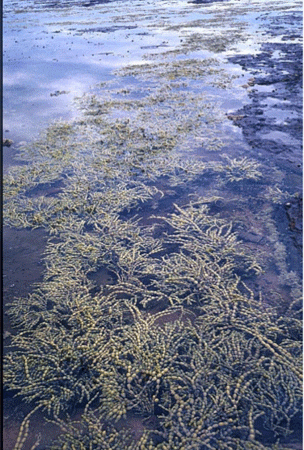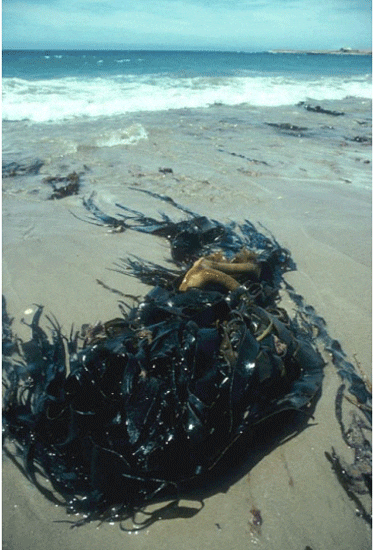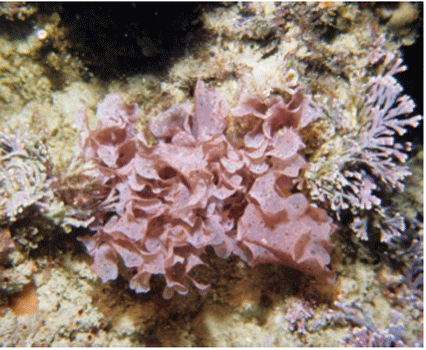What are macroalgae?
Macroalgae are members of the huge group of aquatic plants know as algae (singular alga'). The algae (the primary producers of the planet) are primitive photosynthetic plants that include the single celled phytoplankton of the multi-celled macroalgae, or seaweeds, that can range in size from microscopic to the massive bull kelps (Durvillaea) and giant kelps (Macrocystis)
Macroalgae should not be confused with seagrasses. The latter are closely related to land plants as they have roots, vascular tissue produce flowers and pollen.
Macroalgae on the other hand, derive all their nutrients directly from the surrounding water through their tissue, a bit like a sponge soaks up moisture, and their holdfasts are purely for physically anchoring the thallus to the seabed While seaweeds do reproduce sexually, their reproductive structures are mostly microscopic and require fine dissection to be revealed.
Most macroalgae fall into four basic groups: the blue-green algae (Cyanophyta/Cyanobacteria) that are often associated with blooms in rivers: the green algae (Chlorophyta) such as sea lettuce; the brown algae (Heterokontophyta) that include the large kelps; and the red algae (Rhodophyta) the most diverse group of all.
The red algae should not be confused with red tides which are actually caused by single-celled algae (phytoplankton), some species of which can produce toxins that can kill fish or cause paralytic shellfish poisoning. No marine macroalgae are known to be toxic or harmful to humans. These different colours of algae are the result different photosynthetic pigments or chlorophylls that each alga uses and these reflect different wavelengths of light.
Where are macroalgae found?
With few exceptions, macroalgae are strictly benthic plants; that is they are always attached to the seabed or a solid substratum such as natural reef, rocks, shells, mangrove roots, boat hulls, jetty piling mooring lines etc. When dislodged, most macroalgae have a limited lifespan as free floating seaweed drift and they may only live for hours to several months.

Only a few macroalgae, such as Caulerpa species, can grow in soft sediments and anchor themselves either with long root-like rhizoids or simply by entanglement around seagrass fronds.
Macroalgae grow both intertidally and subtidally. Because they derive their nutrients by diffusion through their tissue, the water movement across fronds has to be continually refreshed and by being anchored to the seabed, they increase their chances of this. When floating with the curents and tides, the water surrounding them immediately is not replenished as rapidly.
The one notable exception is a species of Sargassum. The famous Sargasso Sea (western north Atlantic) is named after this seaweed that floats there in massive rafts and can maintain itself by simple fragmentation.
Since macroalgae are true photosynthet organisms, they can only grow in the photic" zone of the coastal regions, where the light penetrates sufficiently for photosynthesis to occur. In clear waters, macroalgae can survive and grow at depths of over 200 metres, but in murky water this is reduced to only a few metres.
Along the NSW coast the maximum depth for most macroalgae is about 35-45 metres.

Significance
As a result of their photosynthetic activity, marine algae (macroalgae and phytoplankton) are considered to produce between 50% and 75% of the earths oxygen as well as taking up about 25% of the carbon dioxide.
Crustose coralline algae, a very significant group of red seaweeds, make rocks look pink in colour and, when broken apart, are major contributors to the sediments of intertidal and subtidal reefs as they actively lay down Calcium Carbonate (chalk) in their tissues.
Geological cores taken on the Great Barrier Reef have shown that up to 70% of the marine sediments are made up of calcium carbonate deposits from the green algal genus Halimeda. In fact, they should probably be called macroalgal reefs rather than coral reefs.
Macroalgae are an important resource as food and/or shelter for a large range of fish, shellfish and other invertebrate species, and they often act as nurseries for juvenile fish. As drift, seaweeds are a vital food source for many beach invertebrates and, when rotting on the sand, they return vital nutrients back into the beach ecosystem.
Globally, macroalgae have been valued at about 11 billion dollars annually. Kelp forests are four times more productive per square metre than any intensively farmed crop on land.
Macroalgae can be harvested from natural stands, such as the fast-growing Macrocystis forests along the coast of California where the seaweed grows up to 50 cm a day. Alternatively, they can be farmed in large aquaculture enterprises. In these, the algal spores and/or young plants are seeded onto special ropes that are then attached to long- lines or other structures where they are left to grow for several months before harvesting.
In countries such as the Philippines, the seaweed industry, which is based largely on aquaculture, is one of the largest contributors to the nations Gross Domestic Product.
Japan is the largest grower and producer of macroalgae in the world and they grow many different types of seaweed for food (eg, the red algal genus Porphyra which is dried to make nori sheets for sushi rolls) or for a range of secondary products such as agar, carrageenen and alginates which are used extensively in making processed foods, pharmaceuticals and cosmetics.
In New South Wales, as in Australia as a whole, very few algae are collected for commercial purposes. The reason for this is that, while NSW is high in diversity of macroalgal species, no one algal species occurs in sufficiently large amounts or grows or recruits rapidly enough to make it commercially viable for harvesting.
Some macroalgae respond rapidly to, and thrive within, waters that receive increased nutrients and often can be used as indicators of water quality. At certain times of the year, especially in spring when water temperatures and day lengths increase coupled with some heavy rainfalls supply nutrients from runoff to the coast and estuarine environments, macroalgae can bloom in massive quantities. In all instances so far studied, the algae involved in these blooms are harmless, non-toxic native species. They are simply responding changes in environmental conditions as most plants do.
These major blooms are mostly natural phenomena and occur all over the world. Within NSW waters, they have recently occurred at places such as Port Macquarie, Port Stephens, Jervis Bay and Merimbula and Pambula on the South coast.
Macroalgae in NSW
There are approximately 800 species of macroalgae presently documented from NSW (Millar 1990; Millar & Kraft 1993, 1994a, 1994b www.aussiealgae.org). The Australian continent hosts the richest marine macroalgal flora in the world with some 3000 species documented.
The southern coast of Australia has about 1200 of these species. The most common macroalgae are not necessarily the most regularly seen as they only grow subtidally. Those that are most easily seen by beachcombers are the greens and browns although the red calcified algae (corallines) are often seen in tide pools and as drift after heavy storms.
Some common macroalgae of NSW
GreensCaulerpa species
Codium species
Ulva species (see lettuce)
Browns
Hormosira banksii
Phyllospora comosa
Ecklonia radiata
Sargassum species
Dictyota bartaryesiana
Durvillaea potatorum (only south of Tathra)
Reds
Crustose corallines
Cryptonemia sp.
Augophyllum delicatum
Loss of species
Macroalgae are an extremely fragile fish habitat that can be easily destroyed. This loss may contribute to declines in the abundance and diversity of fish and invertebrates in some of these estuaries and nearby coastal zones.
Direct human impacts such as mechanical damage, eutrophication, aquaculture, siltation, coastal constructions, and alteration of food web; along with indirect human impacts, including the impacts of climate change, can contribute to a widespread loss of macroalgae.
Already, Sydney Harbour is the site of the worlds first recorded extinction of a seaweed (Millar 2003) due to dredging, trawling, siltation and seabed/habitat destruction.
Some of the large brown algae along the NSW coastline are experiencing a range retraction south as seawater surface temperatures have increased over the last 60-70 years (Millar 2007).
Macroalgae can be damaged directly by boating-related activities and by dredging and reclamation. Foreshore structures such as pontoons and jetties can indirectly impact by shading macroalgae. Natural disturbances such as storm events, floods, extreme wave-action, predation and disease also may contribute to macroalgal loss.
Subtidal macroalgal species diversity and distribution is dependent on, and affected by:
- The diversity of the seabed topography and geology,
- Regions of upwelling where nutrient-rich cold waters reach the surface at certain localised regions along a coastline,
- Anthropogenic entrance modification to intermittently closed and open estuaries and lagoons (which causes decreased flushing & increased residence times),
- Point sources of pollution from industrial discharge, discharge from sewage treatment plants sewage overflow events dumping of nutrient rich wastewater,
- Natural climatic events such as storms,
- The introduction of alien or pest species.



